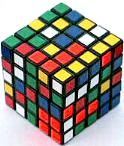


Fig. 1a Fig. 1b Fig. 1c
THE ULTIMATE SOLUTION TO THE
PROFESSOR CUBE
The Professor Cube (5x5x5) has some of the characteristics of Rubik's Cube (3x3x3) and some of those of Rubik's Revenge (4x4x4). For example, the piece in the center of each face is fixed relative to the other five faces. Hence, as with Rubik's Cube, the face colors are predetermined. You will not have to figure out what the color of any one of the faces should be. It is the color of the piece in the center of the face.
But the edge pieces are like the edge pieces of Rubik's Revenge. They may be inverted. However, the inversion is also different from that in Rubik's Revenge. The edge piece is made up of three small pieces (or cubies according to some). While the first and third will always have their colors aligned the piece in the middle may have its colors inverted from the colors on either side.
Naturally you would not deliberately move the three parts into place with the center one turned the wrong way. However, you can control only the first 11 edge pieces. It's the twelfth edge piece which might have its center section inverted. If you encounter this inversion you will have a parity problem and you will correct it in the same manner as with the inverted edge piece in Rubik's Revenge.
The corner pieces are like those in Rubik's Cube. If six are in place then the last two are in place as well. Unlike Rubik's Pocket Cube and Rubik's Revenge (the even numbered cubes) the odd numbered cubes (Rubik's Cube and the Professor Cube) cannot have six corners in place and two out of place.
Even though you will have, at most, one correction to make, the solution for this cube will still require more moves than Rubik's Revenge. After all, there are now 48 center section pieces which must be moved into place along with 36 edge piece parts. .
THE FACE CENTERS
The first step, as with Rubik's Revenge, is to complete one of the center sections, that is, one of the 3x3 sections in the center of each face. (These 3x3 sections will be treated as a single face center piece in the final part of the solution.) Note that there are three different kinds of "center pieces" in a 3x3 section. The first is the one in the center which can only rotate. The second is the piece with an edge adjacent to an edge of the center piece. These have been called "cross pieces" by Davenport/Monroe because, when all are in place on one face, the center piece and these four pieces form a cross. The third type touches the center piece only at a corner and therefore we will call them "center/corner pieces". These three types are not interchangeable.
A 3x3 center section is completed by making strings of three pieces each. The first string contains the center piece (first type) and two cross pieces in a straight line. In Fig. 1a two blue pieces, including a center piece, are already together on the top face. A cross piece is missing. It belongs where the yellow piece is now.
Look at the front (red) face. There are two blue faces in the 3x3 center section. Both are cross pieces. We will use the one in the second vertical slice from the left.



Fig. 1a
Fig. 1b
Fig. 1c
As a general rule, if we wish to turn an inner (second) slice of the cube we will turn the adjacent face as well simply because it is easier and because there is no reason not to do so. If the two left slices are rotated 90o counterclockwise the blue piece from the front face of the cube will move to be adjacent to the blue center piece on the top face. However our three blue pieces will not be in a straight line. We must prepare the top face prior to the turn of the two left slices. Therefore, we rotate the top face 90o clockwise first (Fig. 1b) and then rotate the two left vertical slices 90o counterclockwise. This gives Fig. 1c. We have our first string of three center section pieces.
The next two strings will both contain one cross piece flanked by two center/corner pieces. For the second string we will use the cross piece in the front face, second vertical slice from the right, of the cube in Fig. 1c. We need to put center/corner pieces both above and below this piece. One such piece is found on the back side of our cube and a 180o rotation of the two bottom slices puts it in place as shown in Fig. 2a.
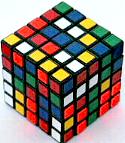
Fig. 2a
There is another blue center piece of the third kind on the front face. It is at the intersection of the second horizontal slice from the top and the second vertical slice from the left. It needs to replace that red piece above our two blue pieces. This can be done quite easily provided we first move that horizontal row out of the front face. Rotate the top two horizontal slices 90o counterclockwise (Fig. 2b) and then rotate the right face 90o clockwise giving the cube in Fig. 2c. The blue piece has replaced the red piece. Now rotate the top two slices 90o clockwise and the second string is completed (Fig. 2d).
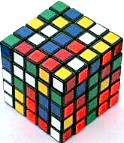

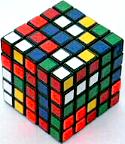
Fig. 2b
Fig. 2c
Fig. 2d
This string is put in place by rotating the top face 90o clockwise (Fig. 3a) and then rotating the two right slices 90o clockwise (Fig. 3b). Now we need to complete the third string of blue center pieces (note that two pieces are already together on the front face in Fig. 3b) and move that string into place completing the blue face of the cube (Fig. 3c).
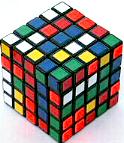
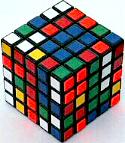
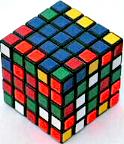
Fig. 3a
Fig. 3b
Fig. 3c
The first face was completed without worrying about disrupting faces which had already been completed. But usually with the second face, and certainly with the third, some moves will move pieces out of place in a face which has already been completed. In such cases it is essential that you use a process which may be described as "go and get" the piece which you want to put in place.
For example, consider the cube in Fig. 4a. The blue face (on the left side of the cube) has already been completed. We are working on the green face and have completed the first string of three green face pieces. The second string has two pieces in place in the second vertical slice from the left on the front face. We want to replace the orange face below those two green faces with the green center piece now in the right face (in the second vertical slice from the back). We could rotate the right face 90o clockwise and then rotate the two bottom slices 90o counterclockwise. The string of three green center pieces would now be complete but we would have moved a string of blue center pieces out of place on the left side of the cube.
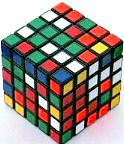
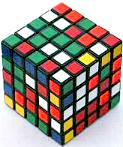
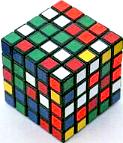
Fig. 4a
Fig. 4b
Fig. 4c
To solve this problem we will send the orange piece to the right face to get the green piece. First we will have to move the green piece out of the second horizontal slice. Rotate the right face 90o counterclockwise (Fig. 4b) and then rotate the bottom two slices 90o clockwise giving Fig. 4c. Note that the bottom string of three face pieces from the blue side now appears on the front face. Rotate the right face 180o (Fig. 4d) and the two bottom slices 90o counterclockwise (Fig. 4e). The string of three green pieces is complete. Rotate the top face 90o clockwise and the two left slices 90o counterclockwise and two strings will be in place on the green face.

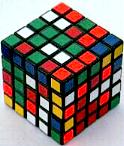
Fig. 4d
Fig. 4e
The last turn of two slices will not disrupt any faces which have already been completed. Hence the "go and get" process is not needed in this case. If either the yellow or orange faces had been completed then a "go and get" process would have been required to bring the second string of center face pieces into the green face.
We can use the "go and get" process either to bring a center/corner piece from another face into place next to our chosen cross piece or we can move a center/corner piece from the same face into a second face, reorient it, and then bring it back into place next to the chosen cross piece. This is what we did in completing the second string of blue center pieces. The "go and get" process is also used to place cross pieces and to move a string of three center pieces into place on the third or fourth faces.
The first four faces should be completed in such a way that the final two faces are adjacent to each other. This is not an absolute requirement but it helps to visualize the final moves. Let's assume that the final two faces are green and white. Use the "go and get" process to maximize the number of green center pieces in the green face. That is, send two or three green pieces from the white face (by a quarter turn of the two vertical front or back slices) to the green face, rotate the green face and bring down as many white pieces as possible. You should turn the green and white faces so that white pieces brought from the white face line up with those already in the green face making the white strings in the green face as long as possible.
The aim is either to reduce the number of white pieces on the green face to one center/corner piece or to complete both green and white faces directly. (The former will also reduce the number of green pieces on the white face to one of the same type.) To assist you, here are some typical examples of cube faces which you will encounter.
In Fig. 5a, rotate the two front slices 90o counterclockwise. Rotate the top face 90o clockwise. Rotate the two front slices 90o clockwise. The number of white pieces in the green face has been reduced from four to three. This creates a cube similar to that in Fig. 5c.
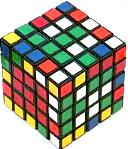
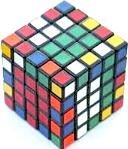
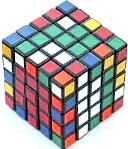
Fig. 5a
Fig. 5b
Fig. 5c
The cube in Fig. 5b is a straightforward example of a "go and get" process in which two strings of three center pieces each are exchanged and all faces are completed.
In Fig. 5c, rotate the two slices on the back of the cube 90o clockwise. Rotate the top face 180o. Rotate the two slices on the back 90o counterclockwise.
In Fig. 5d, rotate the two slices on the front of the cube 90o counterclockwise. Rotate the top face 90o clockwise. Rotate the two slices on the front of the cube 90o clockwise.
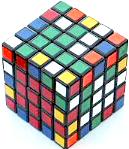
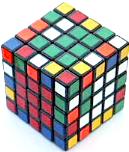
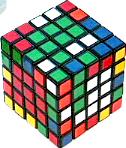
Fig. 5d
Fig. 5e
Fig. 5f
In Fig. 5e, rotate the front two slices 90o counterclockwise. Rotate the top face 90o counterclockwise. Rotate the front two slices 90o clockwise.
In Fig. 5f, rotate the front two slices 90o counterclockwise. Rotate the top face 90o clockwise. Rotate the front two slices 90o clockwise.
The moves described for the cubes in 5c, 5d and 5e leave you with one center/corner piece of the opposite color in each of the green and white faces. On the other hand the example in Fig. 5f completes the cube faces.
Most of the time you will wind up with the situation shown in Fig. 6a. In this case the final two faces are completed by the following process: rotate the two back slices 90o clockwise; rotate the top face 90o clockwise; rotate the two back slices 90o counterclockwise. You now have a string of three white pieces in the green face and a string of three green faces in the white face. Use the "go and get" process to exchange these two strings.
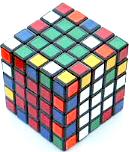
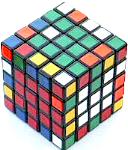
Fig. 6a
Fig. 6b
On occasion you might obtain the cube shown in Fig. 6b. In this case the single foreign piece in each of the white and green faces is a cross piece. Rotate the two back slices 90o clockwise. Rotate the top face 90o clockwise. Rotate the two back slices 90o counterclockwise. The result is the same as Fig. 5e, except that both the green and white faces have been turned. Turn the faces so as to duplicate that figure and carry out the process described there.
THE EDGE PIECES
In Rubik's Revenge you had to pair up two parts for each "edge piece". You had no trouble getting the colors to match. In the Professor Cube there are now three pieces which must be brought together. You will have no trouble with the alignment of the two outside pieces. If the yellow color of the blue/yellow piece at the top faces to the right then so will the one at the bottom. You won't be able to put it into it's proper space with any other alignment. But the piece in the middle is different. It can go into place facing in either direction and you have to make sure you get it right.
In Fig. 7a two parts of the yellow/white edge piece are already in place so that a 180o horizontal rotation of the top two slices would bring them together. The white face of a yellow/white piece shows at the top of the front/left edge. You can see a yellow face in the middle of the right/back edge. The color on the back side is white. However, the third yellow/white edge piece part is not in place. Rather, you can see it on the right/top edge of the cube. It could be moved into place along side the other yellow/white pieces if it were at the bottom of the right/front edge of this cube, that is, where the orange/yellow piece is Figure 7a. In order that it face in the correct direction its white face must be in the blue face of the cube.
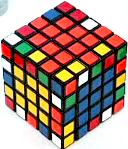
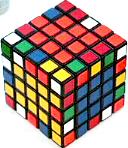
Fig. 7a
Fig. 7b
The following Edge Piece Series will put this yellow/white piece where we want it.
right face 90o counterclockwise
front face 90o clockwise
right face 90o clockwise
front face 90o counterclockwise
The yellow/white piece is now at the lower part of the right/front edge as shown in Fig. 7b.
The bottom two slices are held stationary. The middle horizontal slice is rotated 90o clockwise (looking down from the top) and the top two slices are rotated 90o counterclockwise. This gives the cube in Fig. 7c.
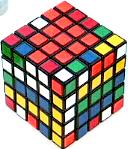

Fig. 7c
Fig. 7d
The yellow/white edge piece has been correctly joined but we must remove it from its current position in order to preserve it. Again this is done with an Edge Piece Series.
right face 90o clockwise
top face 90o counterclockwise
right face 90o counterclockwise
top face 90o clockwise
This gives the cube shown in Fig. 7d. Reversing the original turns of the horizontal slices restores the four vertical faces (yellow, blue, green and white). You have put one edge piece together. You must now repeat this process for nine other edge pieces.
Sometimes you will find two parts of an edge piece side by side with the proper orientation relative to each other. Good. Find the third part and put it in place relative to the other two using the method described above.
When you have reduced the number of scrambled edge pieces to four or three you must remember to place one of the remaining scrambled edge pieces on either the top or bottom of the cube. This follows because you must use a scrambled edge piece to replace (and thus preserve) the next edge piece you put together.
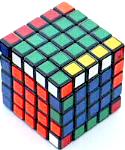
Fig. 8a
When you get down to two scrambled edge pieces you must change your approach. In Fig. 8a the edge pieces at right/front and right/back are scrambled. The top and middle parts of the edge piece at right/back both have blue on the back side. The bottom part has green on the back side. If you turn the two bottom slices clockwise by 90o you would find that the orange/blue edge piece would be complete. On the other hand, if you turned the two bottom slices 90o counterclockwise you would find that the three blue/green edge piece parts would be together but would have an inverted middle section.
You might think that this would mean that our cube has a parity problem. In fact it does not. You would have a parity problem only if the process described above showed either that both edge pieces have an inverted middle section or that neither has an inverted middle section.
But how do we get these edge piece parts together? Rotate the front face by 180o giving the cube in Fig. 8b. The effect of this turn is to invert all three parts of one of the scrambled edge pieces. Now instead of having one of its parts in each of the second, third and fourth horizontal slices (as in Fig. 8a) each of the two remaining edge pieces has two of its parts in the same horizontal slice. There are two orange/blue parts in the second horizontal slice from the top of Fig. 8b and two blue/green parts in the fourth horizontal slice from the top.
Now rotate the two bottom slices so that one part of the blue/green pair which do not match is replaced by the second part in the fourth slice from the top (giving the cube in Fig. 8c). (The entire cube in this figure has been rotated 90o counterclockwise about an axis from top to bottom in order to get a complete view of the edge piece in question.) The two adjacent parts of the blue/green edge piece now have matching colors.
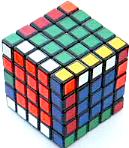
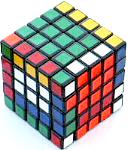
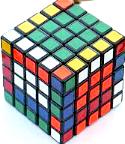
Fig. 8b
Fig. 8c
Fig. 8d
Use an Edge Piece Series to remove the scrambled edge piece from the right/front edge. Now use another Edge Piece Series to return this edge piece to the right/front edge but in an inverted position (Fig. 8d). Each of the parts in this edge piece has been turned around. When the two bottom slices are rotated 180o the blue/orange part will return to match the other two blue/orange parts on the left/back of our cube and the blue/green part will come to the right/front and will match the blue/green parts already there.
If you should actually obtain a cube in which the final edge piece is inverted (Fig. 9) then you can change it by using the same method used for Rubik's Revenge. Turn the two bottom slices 90o. This disrupts four faces around the cube as well as four edge pieces (including the faulty edge piece). Restore each face in order around the cube using the "go and get" process. (Do not simply turn the bottom two slices back 90o.) Now restore the four edge pieces. The edge piece inversion will have been removed.

Fig. 9
FINISHING THE CUBE
Once the faces and the edges have been restored the Professor Cube will behave just like a standard 3x3x3 Rubik's Cube. Hence the cube is completed using the procedures of the Ultimate Solution to Rubik's Cube.
This method requires about 245 moves (nearest multiple of 5) to solve a scrambled Professor Cube provided we do not encounter a parity problem. But an inverted edge piece adds only about 25 moves because we can recognize it even before all edge pieces have been restored. On the other hand, with Rubik's Revenge you must restore all edge pieces and then put them in place before you will know that the last one is inverted. Oddly enough, the number of moves required to solve a Professor Cube, including the correction (about 270 moves), is not much more than that required for Rubik's Revenge with its corrections (about 235 moves).